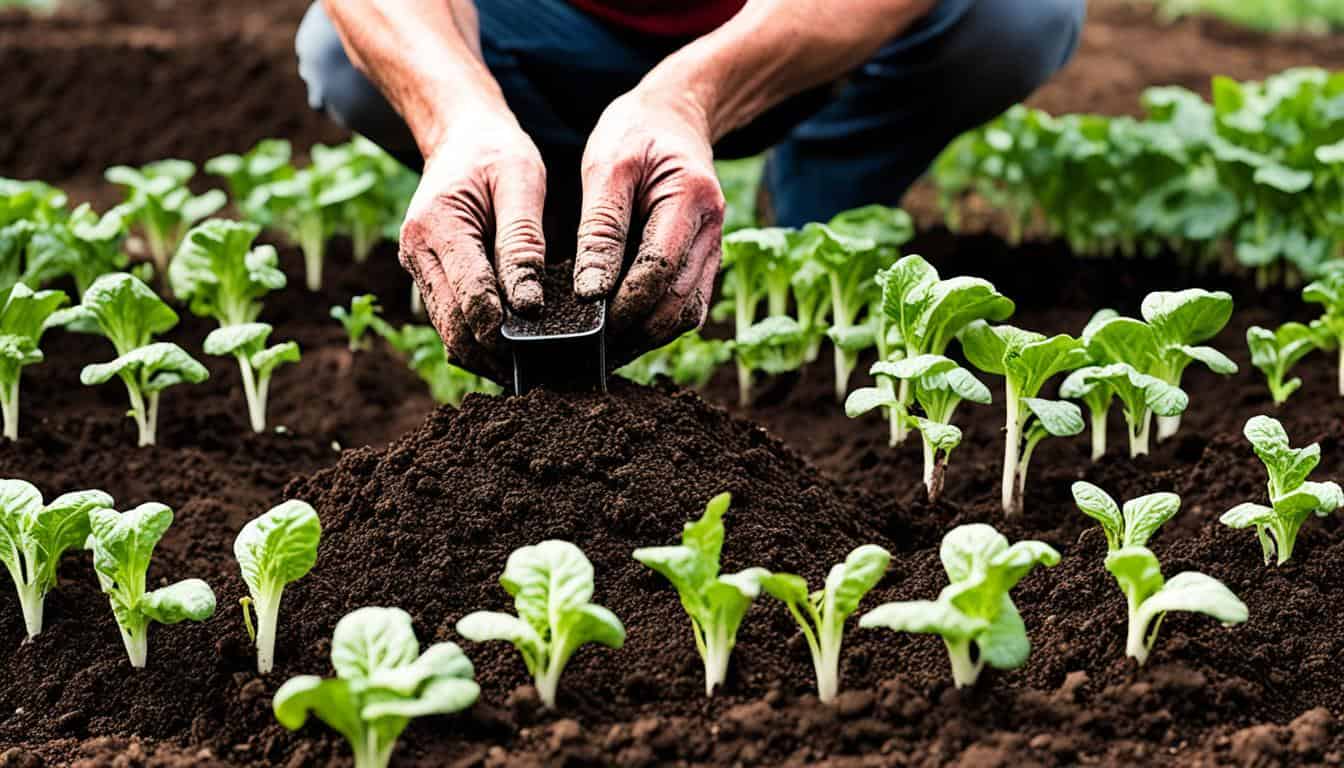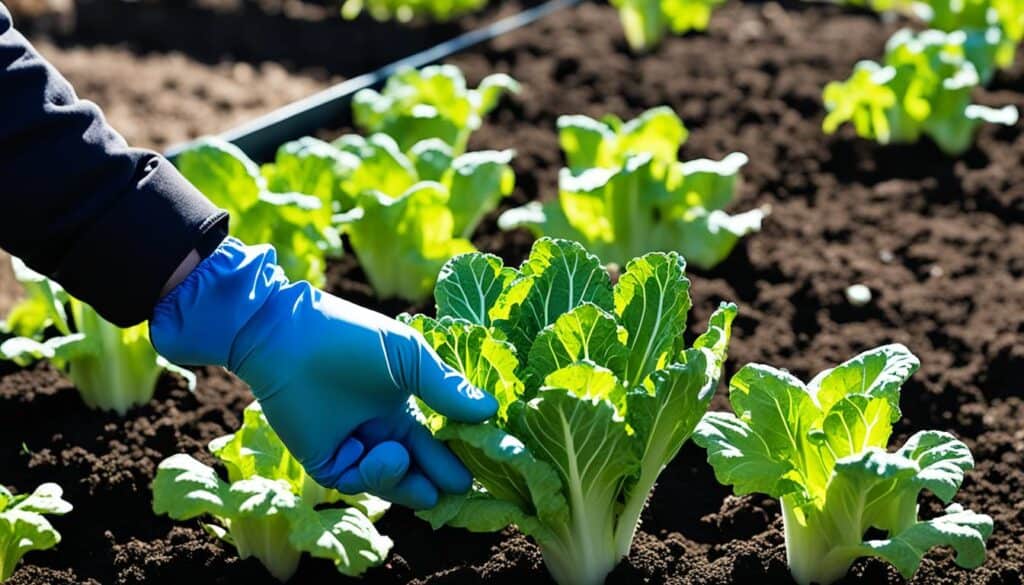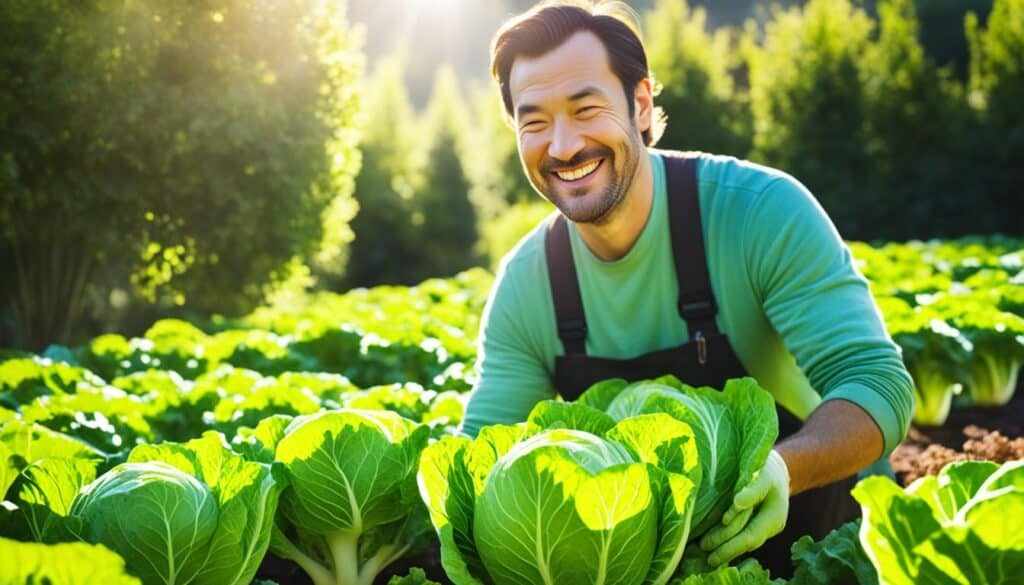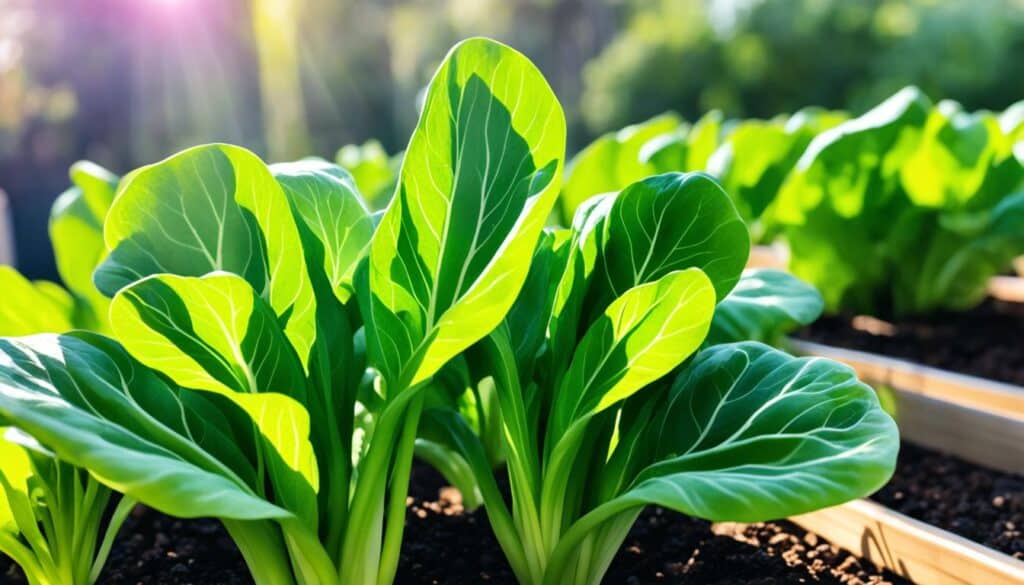Did you know that Chinese cabbage, also known as Napa cabbage, is one of the easiest vegetables to grow in home gardens? Not only does it provide a fresh and healthy addition to your meals, but it also requires minimal maintenance and can thrive in a variety of climates. Whether you’re a seasoned gardener or a beginner, cultivating Chinese cabbage in your backyard is a rewarding and enjoyable experience.
Key Takeaways:
- Chinese cabbage, also known as Napa cabbage, is an easy vegetable to grow in home gardens.
- It provides fresh and healthy leafy greens for your meals.
- Chinese cabbage can thrive in a variety of climates and requires minimal maintenance.
- Whether you’re a seasoned gardener or a beginner, you can successfully cultivate Chinese cabbage in your backyard.
- Stay tuned for essential tips on soil preparation, planting, care, and harvesting Chinese cabbage.
Quick Facts About Chinese Cabbage
Chinese cabbage, also referred to as Napa cabbage, is a fall crop in most regions. It belongs to the Brassica rapa family and is known for its tall, dense, barrel-shaped heads of pale, thin, tender leaves. Chinese cabbage prefers well-drained yet moisture-retentive, fertile soil with a pH range of 6.0 to 7.5. It is recommended to plant Chinese cabbage in an area where you haven’t grown cabbage, broccoli, cauliflower, turnips, rutabaga, or Brussels sprouts in the last four years. July is the ideal time to plant Chinese cabbage seeds directly in the garden.
Chinese cabbage, also known as Napa cabbage, is a fall crop that produces tall, barrel-shaped heads of pale, tender leaves. It prefers well-drained yet moisture-retentive soil with a pH range of 6.0 to 7.5. To ensure optimal growth, it is recommended to plant Chinese cabbage in an area where you haven’t grown certain related vegetables in the recent past. July is the perfect time to plant Chinese cabbage seeds directly in your garden for a bountiful autumn harvest.
Soil Preparation for Chinese Cabbage
Chinese cabbage, like any other plant, requires a suitable soil environment to thrive. Proper soil preparation is essential for the successful cultivation of Chinese cabbage in your garden. Here are some important steps to follow:
Soil pH
Chinese cabbage prefers a soil pH range of 6.0 to 7.5. It is important to have your soil tested before planting to determine its pH level. If the pH is outside the recommended range, you may need to make adjustments. You can increase the pH level by adding agricultural lime or decrease it by incorporating elemental sulfur into the soil.
Soil Fertility
To ensure optimal growth and development, Chinese cabbage needs fertile soil. Adding well-rotted manure or compost to the soil can enhance its fertility. These organic amendments provide essential nutrients and improve the soil structure. However, avoid using fresh manure, as it may contain harmful bacteria and increase weed problems. Instead, use compost or well-rotted manure to enrich the soil and promote healthy plant growth.
Amendments and Fertilizers
In addition to organic matter, you may need to amend your soil with other fertilizers based on the soil test results. Choose a balanced fertilizer that contains nitrogen, phosphorus, and potassium (NPK) in appropriate ratios for vegetable crops. However, it is crucial to avoid fertilizers containing weed killers, as they can harm your Chinese cabbage plants. Always follow the manufacturer’s instructions when applying fertilizers.
Tip: Have your soil tested before planting to determine its pH level and nutrient deficiencies. Based on the results, make the necessary amendments to create a suitable growing environment for Chinese cabbage.
Image of Soil Preparation:
Incorporating these soil preparation practices will set the stage for healthy Chinese cabbage plants and a bountiful harvest. By ensuring the right pH level and fertility, you provide an optimal growing environment for your plants to thrive. Remember, healthy soil leads to healthy plants!
Planting Chinese Cabbage
When it comes to planting Chinese cabbage, direct seeding is the best method for success. It is recommended to sow the seeds directly in the garden in July, as this will allow for a two-month growth period and a harvest before the arrival of a hard freeze.
When planting the seeds, it is important to do so shallowly, at a depth of about one-fourth to one-half inch. For proper spacing, place the seeds every 12 inches if you’re growing dwarf varieties, and every 18 inches for full-sized heads. After the seedlings emerge, thin them out by keeping one plant every 12 to 18 inches. This will ensure sufficient space for the plants to grow and develop.
| Variety | Spacing |
|---|---|
| Dwarf | 12 inches |
| Full-sized heads | 18 inches |
To protect the young Chinese cabbage plants from extreme weather conditions, it is advisable to use row covers. These covers act as a shield, providing protection against insects, wind, and cold temperatures during the initial growth period. Row covers can significantly contribute to the healthy development of your Chinese cabbage plants.
Caring for Chinese Cabbage
Proper care is essential for the healthy growth of Chinese cabbage. By following these tips on watering, mulching, weed control, and pest and disease management, you can ensure a bountiful harvest.
Watering
Chinese cabbage requires consistent moisture throughout its growth period. It is vital to water the plants regularly and provide about one inch of rainfall per week. Sandy soils may require more frequent watering, while heavy clay soils need less. Keep an eye on the soil moisture and adjust the watering schedule accordingly.
Mulching
Mulching plays a vital role in weed control and moisture retention. Adding a layer of organic material such as straw, hay, or shredded leaves around the base of the plants can help reduce weed growth and conserve soil moisture. Apply a mulch layer of about 2-3 inches thick, ensuring it does not touch the stems to prevent rotting.
Weed Control
Frequent shallow cultivation can effectively control weeds in your Chinese cabbage bed. Gently loosen the soil surface using a hoe or hand tools to disrupt weed growth. Be careful not to damage the shallow roots of the cabbage plants while removing weeds. Consider using organic mulch or landscape fabric to further suppress weed growth.
Pests and Diseases
Chinese cabbage is susceptible to various pests and diseases, including flea beetles, cabbage worms, and clubroot. Regular monitoring is crucial to detect any signs of infestation or disease early on. If pests are present, consider appropriate pest control methods such as manual removal, insecticidal soaps, or natural predators. For disease management, ensure proper sanitation practices, crop rotation, and the use of disease-resistant varieties.
“Proper care and attention to watering, mulching, weed control, and pest management are essential for ensuring the success of your Chinese cabbage crop.”
If you’re unsure about identifying and managing specific pests or diseases affecting your Chinese cabbage plants, consult your local extension office or gardening resources for assistance. Taking proactive measures to care for your Chinese cabbage will help promote healthy growth and a bountiful harvest.
Continue reading to learn more about harvesting Chinese cabbage and other related gardening topics.
Harvesting Chinese Cabbage
Harvesting Chinese cabbage is a crucial step in enjoying the fruits of your labor. By following the right techniques, you can ensure that your cabbage is flavorful and preserved for future use.
- Timing: Chinese cabbage is ready for harvest when the heads reach a usable size and feel firm and dense when pressed. It is important to wait until maturity to maximize flavor and texture.
- Cutting: To harvest Chinese cabbage, cut the heads off above the outer leaves. The cabbage cannot stand in the garden once mature, so it’s essential to remove it carefully.
- Harvest Promptly: It is best to harvest Chinese cabbage promptly to prevent bolting, which is when the plant prematurely produces flowers. Bolting can negatively affect the taste and texture of the cabbage.
- Storage: Chinese cabbage can be stored for weeks or even months under specific conditions. It is important to store the cabbage in a cool environment with a temperature range of 32°F to 40°F and 95% humidity. This will help prolong its shelf life.
- Freezing: If you have an abundant harvest, freezing Chinese cabbage can be a great option. Blanched and properly packed, it can stay fresh for months in your freezer, ready to be used in stir-fries, soups, and other dishes.
- Fermentation: Another fantastic way to preserve Chinese cabbage is through fermentation. Fermented cabbage, such as sauerkraut or kimchi, not only enhances the cabbage’s shelf life but also adds a tangy and flavorful element to your meals. Fermented cabbage can be stored for weeks in the refrigerator, ready to be enjoyed at any time.
With these harvesting and preservation techniques, you can make the most of your Chinese cabbage harvest, ensuring a fresh and flavorful supply throughout the year.
| Preservation Method | Benefits |
|---|---|
| Storage | Extended shelf life of cabbage |
| Freezing | Convenient option to preserve cabbage for later use |
| Fermentation | Enhances flavor and adds a tangy element for various dishes |
Growing Bok Choy (Chinese Cabbage)
Bok choy, also known as pak choi, is a variety of Chinese cabbage that offers a unique addition to your garden. With its dark green leaves and thick white or light green stalks, bok choy adds both visual appeal and culinary versatility to your homegrown produce.
Bok choy is a quick-maturing crop that can be harvested continuously by picking the outer leaves, allowing you to enjoy fresh greens throughout the growing season. It prefers similar growing conditions as Chinese cabbage, making it an ideal companion plant in your garden.
| Growing Bok Choy (Chinese Cabbage) | |
|---|---|
| Sunlight Requirements | Full sun to partial shade |
| Soil Type | Well-drained, fertile soil |
| Watering Needs | Consistent moisture |
| Planting Time | Spring or fall |
| Spacing | 12-18 inches apart |
While Chinese cabbage trials in different regions have helped determine suitable varieties, specific trials for bok choy in Minnesota have not been conducted. However, you can experiment with different bok choy varieties available in your area to find the ones that thrive best in your garden.
Why Grow Bok Choy?
Bok choy’s mild flavor and crisp texture make it a popular ingredient in many Asian cuisines. Its versatility allows it to be used in stir-fries, soups, salads, and more. By growing bok choy in your own garden, you can have a fresh and abundant supply of this nutritious vegetable at your fingertips.
“I love growing bok choy in my garden. It’s a beautiful plant and adds a unique touch to my dishes. Plus, knowing that I grew it myself gives me a great sense of satisfaction.”
– Michelle, Home Gardener
Whether you choose to grow bok choy for its culinary uses or simply for its ornamental appeal, it is a rewarding addition to any garden. With the right care and attention, you can enjoy the fresh flavors of bok choy right from your backyard.
Container Gardening with Chinese Cabbage
Growing Chinese cabbage doesn’t require a large garden. With container gardening, you can enjoy fresh and crisp Chinese cabbage right on your patio or in small spaces. Here’s how to get started:
- Choose the right container: Select a pot that is at least 8 inches in diameter for each Chinese cabbage plant. Make sure it has good drainage to prevent waterlogging.
- Optimal potting soil: Use well-draining potting soil specifically formulated for container gardening. This will ensure proper aeration and drainage for the Chinese cabbage roots.
- Watering technique: Regular watering is crucial for container-grown Chinese cabbage, as the soil may dry out faster. Water the containers regularly and avoid overhead watering, which can lead to fungal diseases.
- Frequent fertilization: Container-grown Chinese cabbage may require more frequent fertilization compared to plants grown in the ground. Use a balanced liquid fertilizer according to the package instructions.
- Harvesting: Monitor the Chinese cabbage plants closely and harvest the heads as they reach maturity. Enjoy the rewarding experience of picking fresh and nutritious greens for your favorite meals.
With container gardening, you can cultivate Chinese cabbage even in limited spaces. It’s a convenient and rewarding way to have a fresh supply of leafy greens just steps away from your kitchen. Give it a try and savor the flavors of homegrown Chinese cuisine!
Conclusion
Growing Chinese cabbage in your home garden is an incredibly rewarding experience. With these easy tips, you can enjoy the satisfaction of harvesting fresh and healthy leafy greens right from your own backyard. Whether you choose to grow Chinese cabbage or its delicious variety, bok choy, proper preparation, planting, and care are essential for a successful harvest.
Remember to start with well-prepared soil and maintain a consistent watering schedule to ensure your Chinese cabbage thrives. Regularly monitor for pests and diseases, and take necessary measures to address them promptly. With a little patience and dedication, you’ll be able to witness the growth of these versatile vegetables and enjoy the flavors they bring to Chinese cuisine.
So why wait? It’s time to put your green thumb to work and embark on a fulfilling journey of home gardening. Grow Chinese cabbage and bok choy in your own backyard, and savor the joy of harvesting your own leafy greens. Explore different recipes, experiment with flavors, and indulge in the health benefits of these nutritious vegetables. Happy gardening!










Leave a Reply